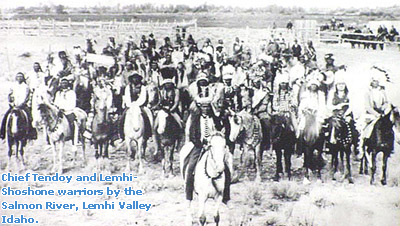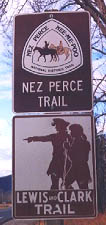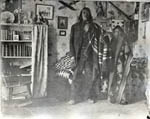Sacajawea and the Lemhi-Shoshone.
This site is dedicated to the Agaidaka (Salmon-Eater Shoshone) and the Tukidika (Sheep-Eater Shoshone) of the Salmon/Lemhi River area.

Welcome back to the official site of the Lemhi-Shoshone, due to funding problems, the www.lemhishoshone.com site isn't online anymore. We have moved to lemhi-shoshone.tripod.com servers for now.
 As many of you that have traveled through Lemhi-Country to present day Salmon, Idaho, you will see many, many "Nez Perce Trail" signs. As many of you that have traveled through Lemhi-Country to present day Salmon, Idaho, you will see many, many "Nez Perce Trail" signs.
But, what the government fails to mention on the sign is that the ONLY time the Nez Perce traveled on the Lemhi-Shoshone trails, was when the U.S. Military was chasing them along with Chief Joseph.
Chief Joseph sent a scout to the Agaidaka camp and asked us to join him, but instead of joining, we gave him over 80 Spanish mustangs (barbs), knowing the advantage of these horses when compared with the U.S. Army's horses.
For those of you that visit the Sacajawea Interpretive Center, notice how the information on this site about how the Lemhi-Shoshone were stripped of federal recognition is once again left out, as well as the information about the Nez Perce Trail signs.
Before the Lewis and Clark bicentennial began and the city of Salmon decided to cash in on this event. The only sign of the Native Americans that had once occupied that area for over ten thousand years, was the local high school, the Salmon Savages and a restaurant called the Savage Circle.
August 2004 Publication of WSU research on Lemhi-Shoshone history:Sacajawea's People: Who Are The Lemhi And Where Is Their Home?
http://www.nebraskapress.unl.edu/bookinfo/4613.html
 Sacajawea's People Sacajawea's People
The Lemhi-Shoshones and the Salmon River Country
By John W. W. Mann - University of Nebraska Press
On October 20, 2001, a crowd gathered just east of Salmon, Idaho, to dedicate the site of the Sacajawea Interpretive, Cultural, and Education Center, in preparation for the Lewis and Clark Bicentennial. In a bitter instance of irony, the American Indian peoples conducting the ceremony dedicating the land to the tribe, the city of Salmon, and the nation the Lemhi Shoshones, Sacajawea's own people had been removed from their homeland nearly a hundred years earlier and had yet to regain official federal recognition as a tribe. John W. W. Mann's book at long last tells the remarkable and inspiring story of the Lemhi Shoshones, from their distant beginning to their present struggles.

Mann offers an absorbing and richly detailed look at the life of Sacajawea's people before their first contact with non-Natives, their encounter with the Lewis and Clark Expedition in the early nineteenth century, and their subsequent confinement to a reservation in northern Idaho near the town of Salmon. He follows the Lemhis from the liquidation of their reservation in 1907 to their forced union with the Shoshone-Bannock tribes of the Fort Hall Reservation to the south.
He describes how for the past century, surrounded by more populous and powerful Native tribes, the Lemhis have fought to preserve their political, economic, and cultural integrity. His compelling and informative account should help to bring Sacajawea's people out of the long shadow of history and restore them to their rightful place in the American story.
John W. W. Mann is a visiting assistant professor in the Department of History at the University of Wisconsin Eau Claire.
Pre-Order your copy here >>
August 2004: Publication: Sacajawea's People: Who Are The Lemhi And Where Is Their Home? Available online at http://www.nebraskapress.unl.edu/bookinfo/4613.html
All proceeds from the book are going to the Lemhi-Shoshone.
 Professor Orlan J. Svingen - Washington State University / Department of History: Professor Orlan J. Svingen - Washington State University / Department of History:
On February 12, 1875, President Grant established a 100 square mile executive order reservation for the Lemhi-Shoshone people in the Lemhi Valley. Known as the Lemhi Valley Indian Reservation, the executive order established the reserve for "the exclusive use of the mixed tribes of Salmon-Eater Shoshone, Sheep-Eater, and Northern Bannock Indians. Almost from the outset, however, the government and local residents began efforts to rescind the executive order reservation. They ultimately succeeded in 1905, and in 1907 the Lemhi began what many have called the "Lemhi Trail of Tears," which saw their forced removal from their ancestral homelands to the Fort Hall Indian Reservation, home of the much larger Shoshone-Bannock Indians (Snake River Shoshone). More >>
Banished from their homelands in 1907 and seeking to return ever since, the Lemhi-Shoshone people create a dilemma for the nation. As it prepares to commemorate the Bicentennial of the Lewis and Clark Corps of Discovery, the United States needs to reassess its commitment to the Lemhi people, to Sacajawea's people. The obligation the nation acknowledges toward wolf and salmon recovery efforts is dwarfed by the responsibility it faces in treating fairly the people who played such a crucial role in advancing the success of the Lewis and Clark Expedition.
More >>
Who are the Lemhi-Shoshone and where is their home? Lemhis are Agaidikas (Salmoneaters), Tukudikas (Sheepeaters), and (Northern) Bannocks and their home is in the Lemhi Valley of Idaho in the Salmon River drainage.
|
- "As the nation commemorates the Lewis and Clark bicentennial with seemingly inexhaustible tributes to her, her people are living as an obscure and repressed minority on a desert reservation nothing like the beautiful mountains of their homeland.
The woman who appears on the Sacajawea coin isn´t a Lemhi-Shoshone, and the tribe of the woman who contributed more than any other to the opening of the West isn´t recognized as a tribe by the federal government.
This is her story and theirs. The story of Sacajawea and her people - by her people."
hotos courtes Research Research
y of Robert Mi
"Sacajawea's People: Who Are The Lemhi And Where Is Their Home?"
By: Professor Orlan J. Svingen History Department, Washington State University
Also read "The Lemhi People and Their Struggle to Retain a Homeland"
By: Shirley Stephens
Also read "The Lemhi Shoshone, Federal Recognition, and the Bicentennial of The Corps of Discovery"
By: John W. W. Mann
How the Agaidikas (Salmon-Eater Shoshone and Sheep-Eater Tribes) became known as the Lemhi
Mormon missionaries who came to the Salmon River Valley in 1855 were the first non-Indians to establish a sustained relationship with the Salmon River Indian people. Approximately twenty-seven Mormon men left the Salt Lake Valley on May 18, 1855. The party reached Fort Lemhi on May 27, and they selected a permanent site for their mission on June 15, 1855. The mission, named Fort Lemhi, was located approximately two miles north of present-day Tendoy, Idaho. The word "Lemhi" was associated with King Limhi who was one of the kings cited in the Book of Mormon. In Mormon scripture, King Limhi organized an expedition that lasted twenty- two days--the same duration it required the Mormon missionaries to reach the Salmon River Country. Consequently, they named their mission after King Limhi, and, in time, Limhi became Lemhi. el . el .
|
National Lewis & Clark Heritage Bicentennial Signature Event
Hartford, Illinois - Both Randy'l Teton and Rod Ariwite were invited to participate in the state of Illinois Lewis and Clark Bicentennial Signature Event to speak on the involvement and contributions of the Lemhi-Shoshone people.
The host tribes for this particular event are the three federally recognized Shawnee Tribes of Oklahoma: Shawnee, Absentee Shawnee and the Eastern Shawnee. Other distinguished Native American experts through out the country were invited to participate in the events.
This particular signature event will move across the Mississippi River to Saint Charles, Missouri - that will kick off on May 20th. Rod Ariwite has been asked by the great-great grandson of Captain William Clark to present at the re-dedication of the William Clark Memorial on Friday, May 21st at the historic Saint Charles National Lewis and Clark Bicentennial Signature Event site.
 The Lewis & Clark Rediscovery project (Lifelong Learning Online): - Explore the Past & Present The Lewis & Clark Rediscovery project (Lifelong Learning Online): - Explore the Past & Present
http://l3.ed.uidaho.edu/ShowOneObject.asp?SiteID=77&ObjectID=832#who
Lemhi Pass Camp Fortunate - 8/13/1805 - Lewis and Clark enter the Lemhi-Shoshones backyard near present day Clark Canyon, Montana and forever changed the lives of the people who had occupied the area for over ten thousand years.
The website content was developed at the University of Idaho, Wheeling Jesuit University, and University of Montana in Missoula. The UM, along with the UI, developed maps, images, GIS, and NASA visualizations that interact with the UI-developed Learning Environment Interface, and compliment the content developed by WJU.
|


View photos, his wife and his son.
|
|
|
 Captain Meriwether Lewis, the personal Secretary of President Jefferson wrote in his journals that Sacajawea was indispensable in their successful attempt to reach the Pacific Ocean and return.
Captain Meriwether Lewis, the personal Secretary of President Jefferson wrote in his journals that Sacajawea was indispensable in their successful attempt to reach the Pacific Ocean and return.
 As many of you that have traveled through Lemhi-Country to present day Salmon, Idaho, you will see many, many "Nez Perce Trail" signs.
As many of you that have traveled through Lemhi-Country to present day Salmon, Idaho, you will see many, many "Nez Perce Trail" signs. Sacajawea's People
Sacajawea's People
 Professor Orlan J. Svingen - Washington State University / Department of History:
Professor Orlan J. Svingen - Washington State University / Department of History:


